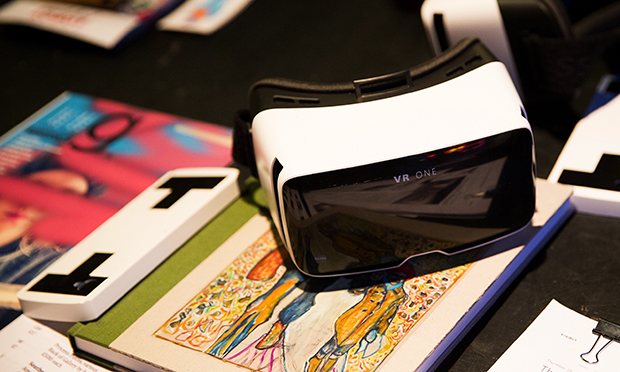Why it’s time for a Virtual Reality check
Do you ever feel overwhelmed by technology? If so, you are not alone. However, tablets and smartphones are only the start. With Virtual Reality on the rise, you will soon be immersed in it. Literally.
Without leaving your living room, you’ll be able to travel the world, feel what it is like to live in a refugee camp in Jordan or visit your new flat before it is built and decide on the interior design.
“Virtual Reality first came around 25 years ago, but people’s imaginations heavily outweighed the technology,” says Steve Dann, a digital media specialist who runs the East London Augmented Reality Meet Up Group.
Now technology is catching up with the imagination, and East Londoners are using Virtual Reality in new and diverse ways, from making virtual art galleries to treating brain injuries and training surgeons.
Storytelling
News journalists and documentary makers could soon be telling stories using Virtual Reality, giving those turned off by conventional news coverage a new way to engage.
Hoxton-based Edward Miller, Head of Visuals at Immersiv.ly, is one of the very first to have filmed an immersive news documentary using 360-degree video.
Hong Kong Unrest, about the city’s pro-democracy protests, was filmed using six Go-Pro cameras clustered in a 3D-printed rig around the size of a Rubik’s Cube.
Louis Jebb, CEO of Immersiv.ly, explains that Virtual Reality is “taking the mediation out of media – or reducing the mediation”.
“For a news piece for example, you feel as a viewer that you are the news editor. For an art gallery you feel like you are the art critic,” he says.
With Virtual Reality, spectators need not be passive or static. The format allows them to change viewpoint, and as they physically enter and move in the space with the help of motion trackers, they can interact, participate and comment.
“With that comes a lot of responsibility,” Jebb adds. “When you take someone into the virtual world they’re going from a place of reality into a place of Virtual Reality so you’ve always got to think about how you bring them back. It is a powerful tool.”
Patients’ recovery
Staring at four walls in hospital is nothing if not boring, but doing so whilst recovering from a brain injury is potentially harmful.
“We know that the environment of post-recovery is incredibly important in determining the extent of your recovery,” says Dr Paul Penn, a lecturer in psychology at the University of East London.
Research co-authored by Penn that was published in 2008 demonstrates the benefits of virtual environments in paediatric neuropsychological rehabilitation following traumatic brain injuries.
Penn explains that creating an enriched and stimulating environment in the real world of the hospital is difficult because of health and safety, cost and time implications. “So if we can’t take a person to a real enriched environment why not take an enriched virtual environment to them?” he asks.
Penn’s research finds that improving the quality of a patient’s environment in the recovery stage “will act as a catalyst for the plasticity that occurs in your brain to help you recover from that injury”.
Penn says that since the hardware is now financially accessible “it is crazy we are not using it in a more applied medical, psychological sense”.
For Penn, gaming can be the perfect way to provide auditory, visual and tactile stimulation, and offers the possibility to monitor patients simultaneously, as well as helping patients visualise their own progress.
Virtual Art gallery
Hackney-based American artist Gretchen Andrew, 28, is an early adopter of Google Glass, a form of hands-free wearable technology that she uses to record her work whilst
she paints.
For four months the artist worked with digital media firms on a Virtual Reality replica of the Los Angeles gallery that represents her, and where she had a show earlier this year.
As you put on a Virtual Reality headset it feels like stepping into the physical gallery, but as you approach each individual frame something happens that is specific to the medium of Virtual Reality.
One of the paintings morphs into the photograph that inspired its creation, another frame shows behind the scenes videos of the paintings being made with Andrew speaking to you, providing insight into her world.
“I want to try to create a conversation around how all of this is real,” Andrew says. “By thinking about it in that way it is easier to think about how we exist both physically and digitally. Our Facebook profiles, our lives on emails, all of that is important and real information about who we are.”
Medical Realities
A year ago, surgeon Shafi Ahmed made history by removing a tumour from the liver and bowel of a patient at the London Royal Hospital whilst live streaming the operation to students using a pair Google Glasses.
“If you pre-record the operation that is okay and a good educational tool, but with live streaming you are watching exactly what is happening from my point of view,” Ahmed says.
As well as the live element, the software being used allows people to type in questions that can be answered in real time by their peers.
There are now three to four live surgeries carried out every month from general surgeries and orthopaedics, to cosmetic surgery and casualties.
Early in 2015, Ahmed co-founded Medical Realities, a group offering medical training products that specialise in Virtual and Augmented Reality.
He says that using Virtual Reality is better practice for students than working with a dead body. “With the interaction, you can create problems… blood loss, for example and if something goes wrong you have to deal with it. It is not just about doing a technical exercise.”
Ahmed estimates Medical Realities is one year away from being able to create an effective Virtual Reality simulation of an operating theatre.


